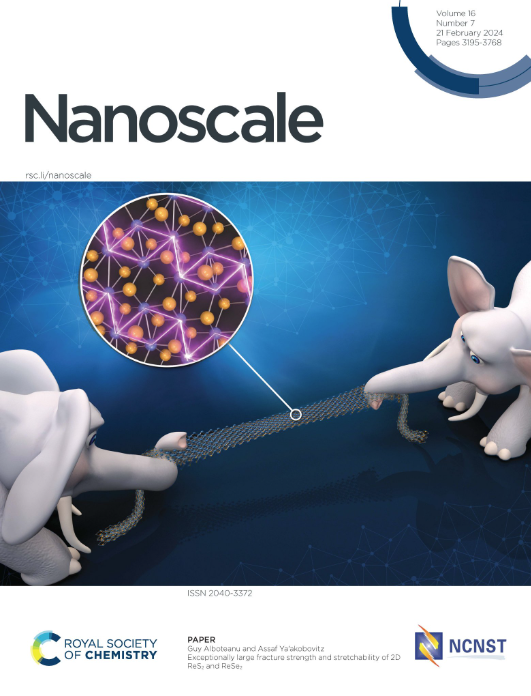石墨氮化碳片的生物降解和巨噬细胞自噬诱导
IF 5.8
3区 材料科学
Q1 CHEMISTRY, MULTIDISCIPLINARY
引用次数: 0
摘要
虽然研究了无金属石墨- c3n4在生物成像、癌症治疗等方面的潜在应用,但其生物降解性及其对免疫调节和自噬诱导的影响尚未报道,这是设计临床应用所必需的。在此,我们研究了两种类型的g-C3N4纳米片(剥落和多孔)的生物降解性,使用来自原代免疫细胞(中性粒细胞)的人髓过氧化物酶(hMPO)、植物酶辣根过氧化物酶(HRP)和光fenton反应(PF,产生羟基自由基)。通过电子显微镜、拉曼光谱、x射线光电子、紫外可见光谱和荧光光谱等光谱技术跟踪了生物降解过程。这些结果证实了hMPO比HRP能更好地降解g-C3N4薄片,其中由于氧基的存在,多孔g-C3N4比剥落的g-C3N4具有更高的可降解性。接下来,使用质谱法应用PF反应来研究降解副产物,并与原始g-C3N4进行比较,评估降解产物的细胞毒性。此外,g-C3N4对RAW264.7巨噬细胞诱导自噬的影响通过自噬标志物LC3蛋白的过表达得到证实,特别是在多孔薄片中观察到明显的自噬。最后,在暴露于多孔g-C3N4和去角质g-C3N4后,在RAW巨噬细胞中也评估了纳米片和细胞因子产生的免疫调节功能。这些发现表明,多孔纳米片诱导了剂量依赖性的促炎反应。本文章由计算机程序翻译,如有差异,请以英文原文为准。
Biological Degradation of Graphitic Carbon Nitride Sheets and Autophagy Induction in Macrophages
Although a metal-free graphitic-C3N4 was studied for potential applications in bioimaging, cancer therapy, etc., its biodegradability and impact on immune modulation and autophagy induction have not yet been reported, which are essential for designing clinical applications. Herein, we studied the biodegradability of two types of g-C3N4 nanosheets (exfoliated and porous) using human myeloperoxidase (hMPO) from the primary immune cells (neutrophils), plant enzyme horseradish peroxidase (HRP) and photo-Fenton reaction (PF, generating hydroxy radicals). The biodegradation was followed by electron microscopy, and spectroscopic techniques such as Raman, X-ray photoelectron, UV-vis and fluorescence spectroscopy. All these results confirmed that the g-C3N4 sheets could be degraded better by hMPO over HRP, where porous g-C3N4 showed higher degradability than exfoliated due to the presence of oxygen groups. Next, the PF reaction was applied to interrogate the degradation by-products using mass spectrometry, and the cytotoxicity of degradation products was assessed in comparison with pristine g-C3N4. Further, the impact of g-C3N4 on the induction of autophagy in the RAW264.7 macrophages was confirmed by over-expression of the autophagy marker, LC3 protein, especially significantly observed for the porous sheets. Finally, the immunomodulatory function of the nanosheets and cytokine production was also evaluated in RAW macrophages following exposure to both porous and exfoliated g-C3N4. These findings demonstrated that the porous nanosheets induced a dose-dependent pro-inflammatory response.
求助全文
通过发布文献求助,成功后即可免费获取论文全文。
去求助
来源期刊

Nanoscale
CHEMISTRY, MULTIDISCIPLINARY-NANOSCIENCE & NANOTECHNOLOGY
CiteScore
12.10
自引率
3.00%
发文量
1628
审稿时长
1.6 months
期刊介绍:
Nanoscale is a high-impact international journal, publishing high-quality research across nanoscience and nanotechnology. Nanoscale publishes a full mix of research articles on experimental and theoretical work, including reviews, communications, and full papers.Highly interdisciplinary, this journal appeals to scientists, researchers and professionals interested in nanoscience and nanotechnology, quantum materials and quantum technology, including the areas of physics, chemistry, biology, medicine, materials, energy/environment, information technology, detection science, healthcare and drug discovery, and electronics.
 求助内容:
求助内容: 应助结果提醒方式:
应助结果提醒方式:


